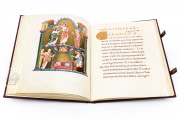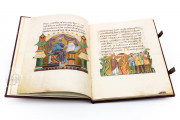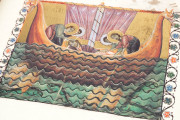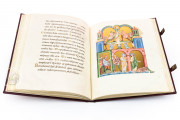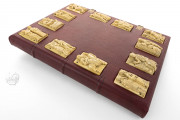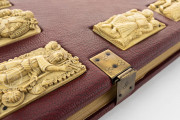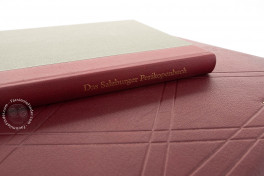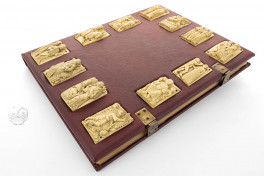Adorned with twelve ivory panels on the binding and an abundance of gold leaf within, the Salzburg Pericopes was produced at the height of ecclesiastical patronage and production in the Ottonian illumination period. Created in Salzburg around 1020, the book presents passages from the Gospels in Latin arranged in the order in which they would be read in the Christian liturgy of the Mass. The manuscript is richly decorated with seventeen miniatures in vibrant colors on gold backgrounds, a painted title page, and a painted incipit page, plus seventy decorated initials in gold and silver.
Probably made for Hartwig (d. 1023), Archbishop of Salzburg, and perhaps in connection with his expansion of the cathedral church, the manuscript constitutes an artistic rival to the Pericopes of Henry II, made around the same time for the Holy Roman Emperor, Henry II.
Majestic Miniatures
Elaborate architectural compositions often serve as frames and dividers for the miniatures that span the width of the leaves and are of varying heights. Several empty spaces and empty pages suggest that further miniatures were planned but never executed. The miniatures form a rich cycle of Christological scenes, evangelist portraits, and the martyrdom of saints.
The book opens with an illuminated title page carrying the somewhat misleading title of LIBER NOVI TESTAMENTUM—book of the New Testament—(fol. 1r) even if the manuscript's liturgical readings are all drawn from the Christian New Testament. The page features a representation of the early Christian theme of the traditio legis (the passing of the Christian tradition from Christ—shown enthroned in heaven—to Saints Peter and Paul).
The next page (fol. 1v) features an unusual image of the Presentation of the Virgin Mary in the Temple as a girl. She is crowned by a descending angel as the priest receives her from her parents. Below is a representation of Joseph's Dream (as described in Matthew 1:18-21). This faces the opening of the text proper (fol. 2r) on a page dominated by a large interlace initial C composed of elaborate golden scrollwork and set in an ornate frame.
Ceremonial Script
The luxuriousness of the codex extends to its script. The text's large Caroline Minuscule written by two or more scribes is accentuated with headings and incipits in gold and red display script incorporating letterforms from the late antique Rustic Capitals and Uncial scripts.
Binding with Ivory Panels
Signaling the luxury of the book's inner contents, twelve carved ivory panels with Christological scenes are embedded into the red leather of the front cover. The panels, probably dating from the tenth century, are thought to have been carved in either southern France or northern Spain.
Confiscated as War Booty
The first flyleaf of the book is a charter from Salzburg dating from 1131. Although the pre-modern history of the book can only be surmised, it is known that the manuscript was taken from the Salzburg archiepiscopal court library by French troops in 1800. The stamps from its sojourn in Paris at the Bibliothèque nationale can still be seen (fols. 1r and 68v). Following Napoleon’s defeat, the book was restituted to Munich in 1815.
We have 2 facsimiles of the manuscript "Salzburg Pericopes":
- Salzburger Perikopenbuch (Standard Edition) facsimile edition published by Faksimile Verlag, 1997
- Salzburger Perikopenbuch (Deluxe Edition) facsimile edition published by Faksimile Verlag, 1997






